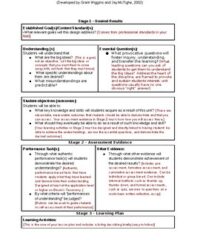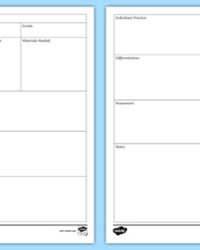Teaching elementary math can be one of the most rewarding parts of an educator’s day, watching young minds grasp concepts like addition, subtraction, or the mysteries of fractions. However, ensuring every student understands and engages with the material requires more than just passion; it demands meticulous planning. Without a clear roadmap, lessons can stray, key objectives might be missed, and precious classroom time can be lost. This is where a well-structured plan becomes an indispensable tool, guiding both the teacher and the students through the learning journey.
Imagine having a consistent framework that helps you prepare for every math lesson with confidence and efficiency. A robust elementary math lesson plan template does precisely that. It streamlines your preparation, ensures all essential components are covered, and ultimately enhances the learning experience for your students. In this article, we’ll explore what makes an excellent template, how to utilize it effectively, and why it’s a game-changer for any elementary math classroom.
Crafting the Perfect Elementary Math Lesson Plan Template
A truly effective lesson plan template isn’t just a blank sheet; it’s a thoughtful guide designed to prompt critical thinking about your instruction. It helps you break down complex mathematical concepts into manageable steps, anticipate student needs, and allocate time wisely. By using a standardized template, teachers can maintain consistency across different units and grade levels, ensuring a comprehensive and coherent math curriculum. This consistency also allows for easier collaboration among colleagues and provides a clear record of what has been taught.
The best templates encourage a holistic approach to lesson design, moving beyond just listing activities. They prompt educators to consider the "why" behind each lesson, connecting daily activities to broader learning goals. They also encourage reflection on how students will demonstrate their understanding, leading to more targeted assessments. A well-designed template is flexible enough to adapt to various teaching styles and classroom environments, yet structured enough to ensure no critical element is overlooked.
Thinking about the specific needs of elementary students, an ideal template emphasizes hands-on activities, opportunities for discovery, and real-world connections. Young learners benefit immensely from seeing how math applies to their everyday lives, whether it’s counting objects, measuring ingredients, or understanding patterns. The template should therefore nudge teachers to incorporate these engaging elements naturally into their planning process.
Furthermore, a comprehensive elementary math lesson plan template should factor in the diverse learning needs present in any classroom. This includes planning for differentiation, supporting students who may be struggling, and enriching the experience for those ready for a greater challenge. It transforms lesson planning from a chore into a creative and strategic exercise, ultimately benefiting every student.
Essential Elements for Your Template
* **Lesson Title and Grade Level:** Clear identification for easy organization.
* **Learning Objectives (SMART goals):** Specific, Measurable, Achievable, Relevant, Time-bound goals for what students will know or be able to do.
* **Materials Needed:** A precise list of all manipulatives, worksheets, technology, or other resources.
* **Warm-up/Engage:** An activity to capture students’ attention and activate prior knowledge.
* **Direct Instruction/Explore:** The core teaching component, explaining new concepts.
* **Guided Practice:** Activities where students work on problems with teacher support.
* **Independent Practice:** Opportunities for students to apply learning on their own.
* **Assessment (Formative and Summative):** How student understanding will be checked throughout and at the end of the lesson.
* **Differentiation and Support:** Strategies for addressing diverse learning needs, including modifications and extensions.
* **Closure:** A summary activity to reinforce key takeaways and prepare for future lessons.
Strategies for Engaging Young Mathematicians
Incorporating interactive and multi-sensory strategies into your lesson plans can significantly boost engagement in elementary math. Think about using games that reinforce number sense, such as “Roll and Cover” for addition facts, or “Place Value War” with playing cards. Real-world scenarios, like planning a party budget or measuring ingredients for a recipe, make abstract concepts tangible. Technology tools, from interactive whiteboards to educational apps, can also bring math to life, offering dynamic visuals and immediate feedback. Encouraging collaborative problem-solving through partner work or small group challenges fosters communication and critical thinking skills, allowing students to learn from their peers and articulate their mathematical reasoning.
Maximizing Your Lesson Planning with a Solid Template
Implementing a high-quality lesson plan template isn’t just about filling in blanks; it’s about transforming your approach to teaching. When you consistently use a well-designed elementary math lesson plan template, you’ll find yourself saving significant time in the long run. Instead of reinventing the wheel for each new topic, you’ll have a structured framework that ensures all critical pedagogical components are considered, from clear learning objectives to diverse assessment strategies. This efficiency allows you to focus more on the art of teaching—student engagement, real-time adjustments, and fostering a love for mathematics.
Furthermore, a standardized template promotes a more reflective teaching practice. As you fill out each section, you’re prompted to think deeply about student understanding, potential misconceptions, and how to best differentiate instruction for all learners. This foresight can dramatically reduce classroom management issues and increase student success rates. It also serves as an invaluable record, allowing you to easily review past lessons, identify areas for improvement, and refine your curriculum year after year.
Ultimately, the consistent application of a robust template elevates the quality of your instruction and the learning experience for your students. It helps ensure that every child is provided with equitable access to high-quality math education, systematically building their foundational skills and confidence. By streamlining the planning process, you empower yourself to be more present and responsive in the classroom, truly connecting with your students as they explore the exciting world of numbers.
Tips for Effective Template Implementation
* **Personalize It:** Don’t be afraid to adjust sections or add notes that are specific to your teaching style or classroom needs.
* **Keep It Flexible:** While structured, remember that a template is a guide, not a rigid rulebook. Be prepared to adapt plans based on student responses.
* **Collaborate with Peers:** Share your elementary math lesson plan template with colleagues to gain new perspectives and shared resources.
* **Review and Revise Regularly:** After teaching a lesson, take a few minutes to jot down what worked well and what could be improved for next time.
* **Focus on Student Outcomes:** Always keep the students’ learning at the forefront of your planning, ensuring every element contributes to their understanding and growth.
Embracing a well-designed lesson planning framework can truly revolutionize how you approach teaching elementary math. It empowers you to deliver engaging, effective lessons that cater to the diverse needs of your students, building their confidence and competence in mathematics from the ground up. By investing time in creating or adapting a template that genuinely works for you, you’re not just organizing your thoughts; you’re cultivating a more impactful and enjoyable learning environment for everyone involved.
As you continue your journey in educating young minds, remember the profound impact a thoughtful and structured approach can have. Leverage the power of planning to ensure every math concept is introduced with clarity, practiced with purpose, and mastered with enthusiasm. This commitment to intentional lesson design will undoubtedly foster a generation of confident problem-solvers and critical thinkers ready to embrace mathematical challenges.


